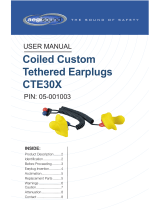Frequently Asked Questions:
What’s wrong with conventional earplugs?
A
They muffle speech and music. Conventional earplugs reduce sound
more in the high frequencies than in the low and mid frequencies, which
makes music and voices unclear and unnatural. Deeply-inserted foam
earplugs can provide 30-40 dB of sound reduction, but only a small amount
is typically needed.
How much protection do people need?
A
Hearing loss is a function of exposure time, the average sound level,
and the peak level of very loud sounds. Some persons are more susceptible
to hearing loss from high-level sound than others. Most musicians do not
need maximum protection, and many industrial workers can be adequately
protected with as little as 10 dB of sound reduction. The majority of
eight-hour-equivalent noise exposure in industry falls between 85 and 95 dB.
Is there a non-custom high fidelity earplug?
A
Yes. Etymotic Research designed and patented ETY•Plugs
™
which are high fidelity ready-fit earplugs that reduce
sound evenly by 20 dB at all frequencies, so that music
and speech are heard clearly. Available in two sizes, for
regular and small ear canals.
Why are deep earmolds required for
Musicians Earplugs?
A
Earmolds need to seal deeply in the bony portion of the ear canal
or the wearer will hear a hollow or boomy sound in their own voice when
speaking, singing or playing a brass or wind instrument. This unpleasant or
distracting sound is called the occlusion effect. Deep earmolds (past the
second bend of the ear canal) will eliminate this problem.
What is the noise reduction rating (NRR)?
A
The U.S. Environmental Protection Agency requires manufacturers
to print a noise reduction rating (NRR) on all non-custom earplugs.
The formula used to determine NRR includes an adjustment for test
variability, individual variability, and for those persons who do not wear ear
protection as instructed. When worn properly, Etymotic earplugs provide more
sound reduction than the assigned NRR value. Laboratory data on subjects
wearing properly sealed ETY•Plugs
™
shows between 18-22 dB average
sound reduction over the 250-8000 Hz frequency range, but the NRR
calculated from the same data is 12 dB.
Q
Q
Q
Q
Q
ER-9
•
ER-15
•
ER-25
EREM-B01-B 0907
Who uses Musicians Earplugs?
ETYMOTIC RESEARCH INC.
Musicians Earplugs
™
• Custom high-fidelity hearing protection
• Sound quality is clear and natural, not muffled
• Noise fatigue and ear overload distortion are reduced
E
E
T
T
Y
Y
M
M
O
O
T
T
I
I
C
C
R
R
E
E
S
S
E
E
A
A
R
R
C
C
H
H
INC.
61 Martin Lane • Elk Grove Village, IL 60007
w
w
w
w
w
w
.
.
e
e
t
t
y
y
m
m
o
o
t
t
i
i
c
c
.
.
c
c
o
o
m
m
•
•
8
8
8
8
8
8
-
-
3
3
8
8
9
9
-
-
6
6
6
6
8
8
4
4
Musicians Earplugs™ is a trademark of Etymotic Research,Inc.The ER family of earplugs is covered by one
or more of the following U.S.patents:#4,852,683, #5,113,967,#5,887,070 and other patents pending.
Industrial
factory workers
shop teachers
students
supervisors
Leisure
concerts
night clubs
noisy restaurants
Construction
carpenters
equipment operators
road builders
steel workers
Aircraft
crew
flight instructors
passengers
pilots
Athletics
athletes
coaches
sporting events
Medical-Dental
dentists
dental hygienists
dental technicians
surgeons
Others
delivery drivers
market traders
night club staff
truck drivers
Music
concerts
marching bands
musicians
night clubs
Motor Sports
motorcyclists
pit crews
race car drivers
spectators
Emergency
Vehicles
EMTs
highway patrol
firefighters
Hearing loss is a function of exposure time, the average noise level and the
peak level of very loud sounds.
Regular Small
Permissible Sound Exposure Guidelines
NIOSH (1998). Criteria for a recommended standard: occupational noise exposure. Cincinnati, OH: U.S. Department
of Health and Human Services, Public Health Service, Centers for Disease Control and Prevention, and National
Institute for Occupational Safety and Health. DHHS (NIOSH) Publication No. 98-126.


